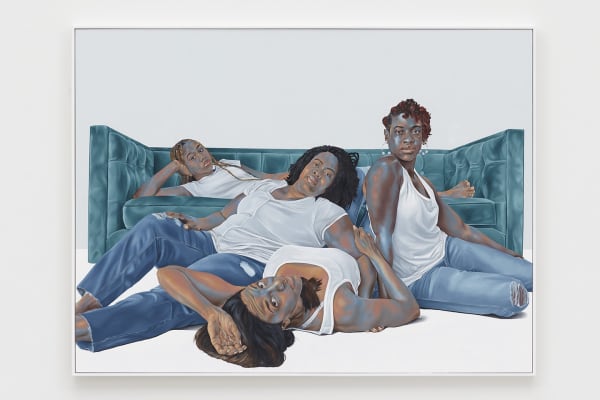Lanise Howard and Robert Peterson: Reflections
-
![Robert Peterson [American, b. 1981] God's Favorite, 2023](data:image/gif;base64,R0lGODlhAQABAIAAAAAAAP///yH5BAEAAAAALAAAAAABAAEAAAIBRAA7) Robert Peterson [American, b. 1981]God's Favorite, 2023
Robert Peterson [American, b. 1981]God's Favorite, 2023 -
![Robert Peterson [American, b. 1981] Soulful, 2023](data:image/gif;base64,R0lGODlhAQABAIAAAAAAAP///yH5BAEAAAAALAAAAAABAAEAAAIBRAA7) Robert Peterson [American, b. 1981]Soulful, 2023
Robert Peterson [American, b. 1981]Soulful, 2023 -
![Robert Peterson [American, b. 1981] Skin Noir, 2023](data:image/gif;base64,R0lGODlhAQABAIAAAAAAAP///yH5BAEAAAAALAAAAAABAAEAAAIBRAA7) Robert Peterson [American, b. 1981]Skin Noir, 2023
Robert Peterson [American, b. 1981]Skin Noir, 2023 -
![Lanise Howard [American, b. 1993] The distance between us, 2023](data:image/gif;base64,R0lGODlhAQABAIAAAAAAAP///yH5BAEAAAAALAAAAAABAAEAAAIBRAA7) Lanise Howard [American, b. 1993]The distance between us, 2023
Lanise Howard [American, b. 1993]The distance between us, 2023 -
![Lanise Howard [American, b. 1993] Lady in Waiting, 2023](data:image/gif;base64,R0lGODlhAQABAIAAAAAAAP///yH5BAEAAAAALAAAAAABAAEAAAIBRAA7) Lanise Howard [American, b. 1993]Lady in Waiting, 2023
Lanise Howard [American, b. 1993]Lady in Waiting, 2023 -
![Lanise Howard [American, b. 1993] Waiting on a memory, 2023](data:image/gif;base64,R0lGODlhAQABAIAAAAAAAP///yH5BAEAAAAALAAAAAABAAEAAAIBRAA7) Lanise Howard [American, b. 1993]Waiting on a memory, 2023
Lanise Howard [American, b. 1993]Waiting on a memory, 2023 -
![Robert Peterson [American, b. 1981] Saint Alexander, 2023](data:image/gif;base64,R0lGODlhAQABAIAAAAAAAP///yH5BAEAAAAALAAAAAABAAEAAAIBRAA7) Robert Peterson [American, b. 1981]Saint Alexander, 2023
Robert Peterson [American, b. 1981]Saint Alexander, 2023 -
![Robert Peterson [American, b. 1981] Saint Gregory, 2023](data:image/gif;base64,R0lGODlhAQABAIAAAAAAAP///yH5BAEAAAAALAAAAAABAAEAAAIBRAA7) Robert Peterson [American, b. 1981]Saint Gregory, 2023
Robert Peterson [American, b. 1981]Saint Gregory, 2023 -
![Robert Peterson [American, b. 1981] Saint Daniel, 2023](data:image/gif;base64,R0lGODlhAQABAIAAAAAAAP///yH5BAEAAAAALAAAAAABAAEAAAIBRAA7) Robert Peterson [American, b. 1981]Saint Daniel, 2023
Robert Peterson [American, b. 1981]Saint Daniel, 2023 -
![Lanise Howard [American, b. 1993] His realization, 2023](data:image/gif;base64,R0lGODlhAQABAIAAAAAAAP///yH5BAEAAAAALAAAAAABAAEAAAIBRAA7) Lanise Howard [American, b. 1993]His realization, 2023
Lanise Howard [American, b. 1993]His realization, 2023 -
![Lanise Howard [American, b. 1993] Hue’Man; his soul shined through, 2023](data:image/gif;base64,R0lGODlhAQABAIAAAAAAAP///yH5BAEAAAAALAAAAAABAAEAAAIBRAA7) Lanise Howard [American, b. 1993]
Lanise Howard [American, b. 1993]Hue’Man; his soul shined through, 2023
-
![Lanise Howard [American, b. 1993] His lure, 2023](data:image/gif;base64,R0lGODlhAQABAIAAAAAAAP///yH5BAEAAAAALAAAAAABAAEAAAIBRAA7) Lanise Howard [American, b. 1993]His lure, 2023
Lanise Howard [American, b. 1993]His lure, 2023
NEW YORK, NY | albertz benda is thrilled to present a two-person exhibition of Lanise Howard and Robert Peterson, artists known for their exquisite paintings of people of color. Both artists hail from the US, with Howard based in Los Angeles and Peterson in Lawton, Oklahoma. Their work resonates on several levels, especially in subject matter and technique, which makes a natural fit for a two-person exhibition. Their paintings are intermingled throughout the gallery space, highlighting an interchange of ideas and motifs that span two distinct practices and allow each to shine individually.
Howard and Peterson were previously included in a group show at albertz benda in Los Angeles. This continues that nascent dialogue in a concentrated exhibition that celebrates the African American experience in the US. Given the lacuna of positive representations of people of color in the history of art, both artists contribute to remedying this historical erasure, creating works that reveal their sitters as beautiful, strong and complex beings. The American painter Barclay L. Hendricks (1945 – 2017) is acknowledged as an inspiration to both artists and their work may be read in this lineage of figurative painting.
Peterson is known for his depictions of young men seen in the reality of their daily lives: do-rags, white tanks, and low-slung jeans, which are often described in pejorative terms in popular culture, are elevated in his work. He focuses, as he says, “on the beautiful thing that is black life”. Working from short photo shoots—he keeps them brief so that they feel natural rather than staged—he uses people from his local area as sitters to create poignant and confident portraits of contemporary black life. These are executed in oil on canvas with an Old Master level of precision. Peterson’s iridescent skin tones become compositions within themselves, revealing a spectrum of color as the viewer moves closer. Soulful, 2023, a double portrait of two men, shows them bare from the waist up against a stark Mahari green (a color invented by Peterson) background. The figures exude an inherent elegance that belays the toil and drama of everyday existence. Also in the exhibition, four small canvases that depict men with halos address the historical absence of dark-skinned people depicted as saints or kings.
Howard creates open calls for models to pose for photographs as source material, and often constructs scenarios in which her sitters wear specific garments in staged poses. Her work positions contemporary African American people as protagonists in paintings that can be read as allegorical and that are often set in ethereal landscapes that imagined a world without colonialization. Howard’s backgrounds range from ombre amber or stormy dark skies to verdant green flora, presenting the earth as a magical protagonist. For this exhibition, Howard shows five canvases that are populated with men, similar to Peterson. His Last Stand His First Flight, 2023 is painted in oil on canvas and features two iterations of the same man in an interior setting. Two birds—frequently featured in Howard’s paintings—fly inside while the man and his doppelganger stand atop a cosmos as floor. In The Distance Between Us, 2023 a man sits on a sofa with an unseen woman’s leg barely in the frame while two birds into the sky that inhabits the space behind the figures. In each of these new paintings, the male subject is seen in nuanced stages of contemplation. Moving the exterior inside is a symbolic adaptation of the psychological state of the man; it also reflects the artist’s tendency to record and then manifest her dreams in the form of paintings.

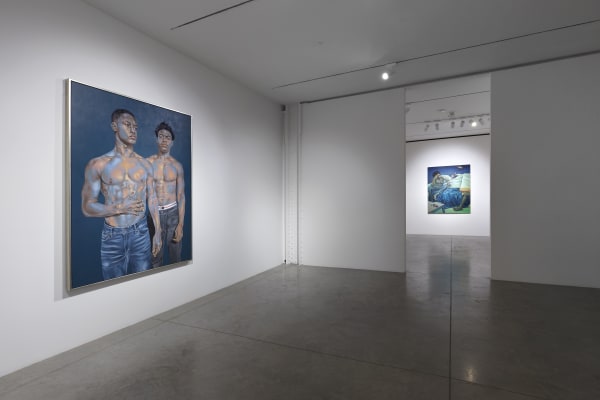
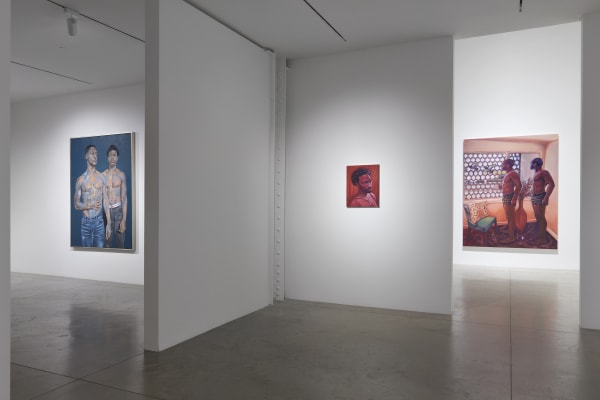
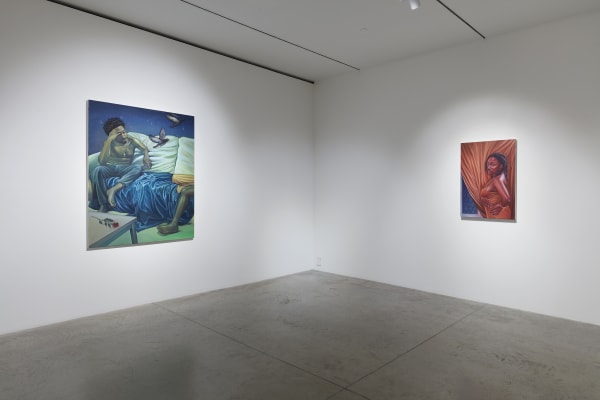
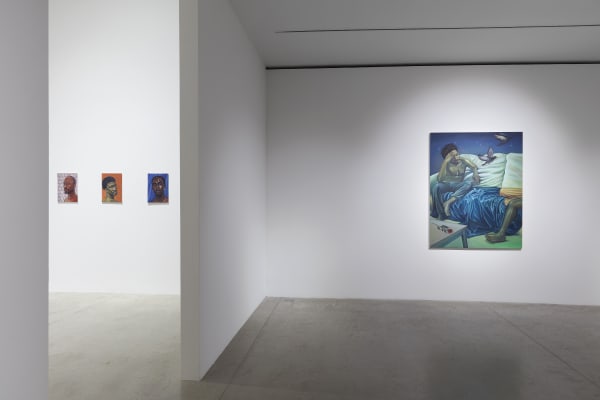
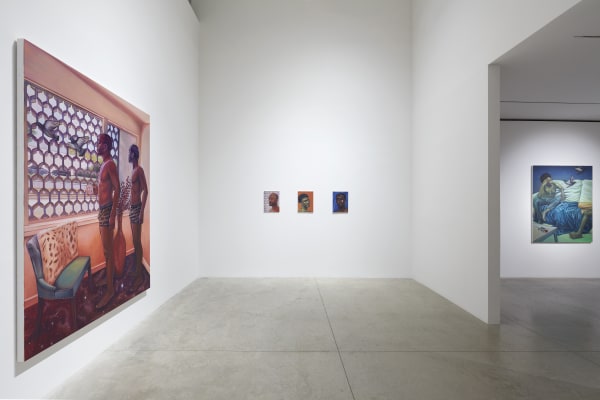
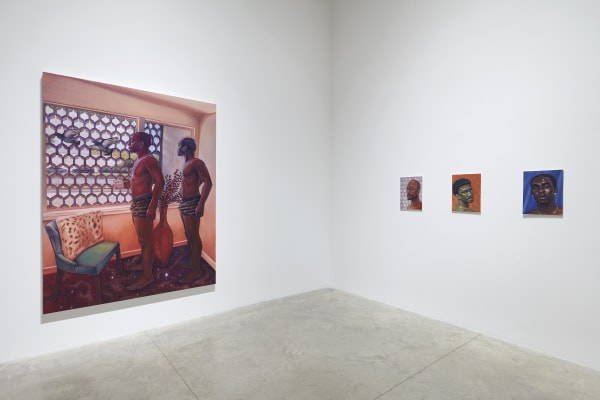
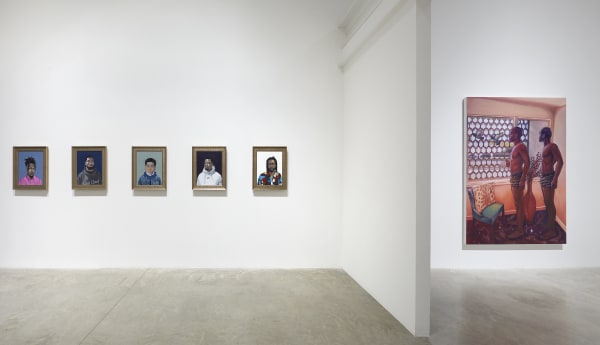
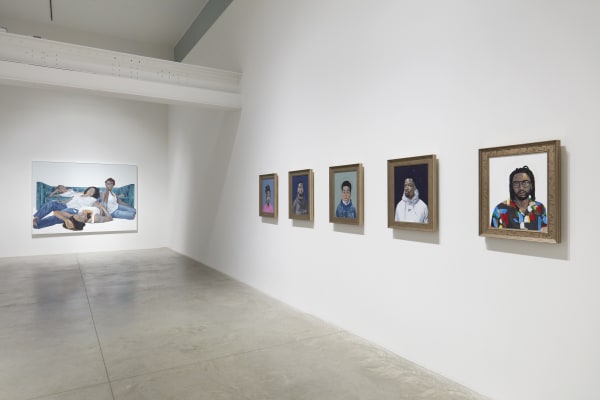


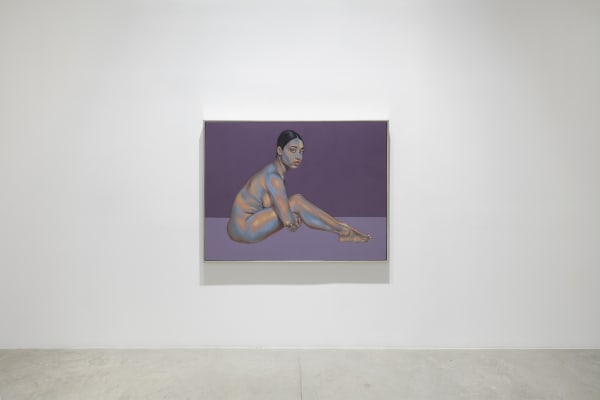
![Robert Peterson [American, b. 1981] God's Favorite, 2023](https://artlogic-res.cloudinary.com/w_600,c_limit,f_auto,fl_lossy,q_auto/ws-albertzbenda/usr/exhibitions/images/exhibitions/101/ab14161_peterson_god-favorite_lg.jpg)
![Robert Peterson [American, b. 1981] Soulful, 2023](https://artlogic-res.cloudinary.com/w_600,c_limit,f_auto,fl_lossy,q_auto/ws-albertzbenda/usr/images/exhibitions/images_and_objects/101/ab14162_peterson_soulful_sm.jpg)
![Robert Peterson [American, b. 1981] Skin Noir, 2023](https://artlogic-res.cloudinary.com/w_600,c_limit,f_auto,fl_lossy,q_auto/ws-albertzbenda/usr/exhibitions/images/exhibitions/101/ab14163_peterson_skin-noir_sm.jpg)
![Lanise Howard [American, b. 1993] The distance between us, 2023](https://artlogic-res.cloudinary.com/w_600,c_limit,f_auto,fl_lossy,q_auto/ws-albertzbenda/usr/exhibitions/images/exhibitions/101/ab14167_howard_the-distance-between-us_lg.jpg)
![Lanise Howard [American, b. 1993] Lady in Waiting, 2023](https://artlogic-res.cloudinary.com/w_600,c_limit,f_auto,fl_lossy,q_auto/ws-albertzbenda/usr/exhibitions/images/exhibitions/101/ab14169_howard_lady-in-waiting_lg.jpg)
![Lanise Howard [American, b. 1993] Waiting on a memory, 2023](https://artlogic-res.cloudinary.com/w_600,c_limit,f_auto,fl_lossy,q_auto/ws-albertzbenda/usr/images/exhibitions/images_and_objects/101/ab14170_howard_waiting-on-a-memory_sm.jpg)
![Robert Peterson [American, b. 1981] Saint Alexander, 2023](https://artlogic-res.cloudinary.com/w_600,c_limit,f_auto,fl_lossy,q_auto/ws-albertzbenda/usr/exhibitions/images/exhibitions/101/ab14207_peterson_saint-alexander_lg.jpg)
![Robert Peterson [American, b. 1981] Saint Gregory, 2023](https://artlogic-res.cloudinary.com/w_600,c_limit,f_auto,fl_lossy,q_auto/ws-albertzbenda/usr/exhibitions/images/exhibitions/101/ab14164_peterson_saint-gregory_lg.jpg)
![Robert Peterson [American, b. 1981] Saint Daniel, 2023](https://artlogic-res.cloudinary.com/w_600,c_limit,f_auto,fl_lossy,q_auto/ws-albertzbenda/usr/exhibitions/images/exhibitions/101/ab14303_peterson_saint-daniel_lg.jpg)
![Lanise Howard [American, b. 1993] His realization, 2023](https://artlogic-res.cloudinary.com/w_600,c_limit,f_auto,fl_lossy,q_auto/ws-albertzbenda/usr/exhibitions/images/exhibitions/101/ab14168_howard_his-realization_lg.jpg)
![Lanise Howard [American, b. 1993] Hue’Man; his soul shined through, 2023](https://artlogic-res.cloudinary.com/w_600,c_limit,f_auto,fl_lossy,q_auto/ws-albertzbenda/usr/exhibitions/images/exhibitions/101/ab14304_howard_hue-man-his-soul-shined-through_lg.jpg)
![Lanise Howard [American, b. 1993] His lure, 2023](https://artlogic-res.cloudinary.com/w_600,c_limit,f_auto,fl_lossy,q_auto/ws-albertzbenda/usr/exhibitions/images/exhibitions/101/ab14225_howard_his-lure_lg.jpg)
